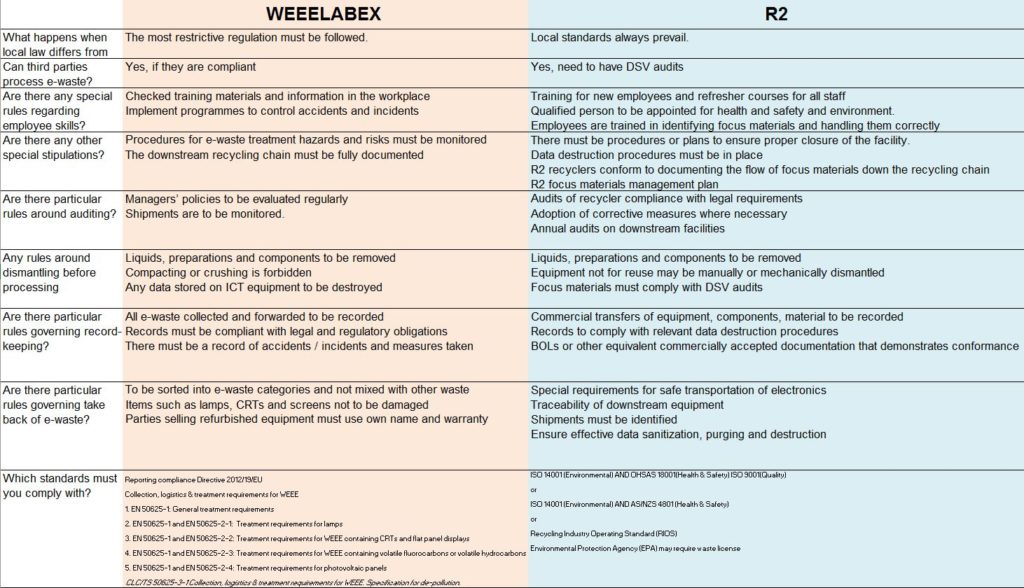Certifications today are created for almost every industry. They help guide managers in vendor selection and help the industry set and maintain a level of standards. Most global companies in need of e-Recycling and IT asset disposition services, are familiar with two widely known and used certifications for e-waste; WEEELABEX and Responsible Recycling (R2). Both standards support the implementation of legal, regulatory and policy frameworks and have a number of points in common.
The standards cover occupational and public health and safety, and environmentally sound management. They also provide scope for the following:
- review of management systems
- actions for continuous improvement of design and implementation
- guidance for legal and regulatory frameworks (including minimum standards and implementation)
- regular monitoring and control
With a focus on WEEELABEX and R2 as two widely recognized standards, here is a short description of each followed by similarities and differences.
WEEELABEX (WEEE forum Association)
Introduced in 2011, WEEELABEX sets out an integrated set of pan-European requirements, separately covering collection, logistics, treatment and outlet management (tracking and tracing). The WEEELABEX Organization has fully implemented general CENELEC WEEE standards into its accredited certification scheme. As new CENELEC standards appear, WEEELABEX will be adapted accordingly.
WEEELABEX certification is voluntary for e-Recyclers to maintain. However most are to manage credibility, and because clients almost always demand this oftentimes because it helps them adhere to the compliance schemes. WEEELABEX-certified operators must have a health, safety, environment and quality system in place that is in line with WEEELABEX or equivalent regulation. It is important to point out that in Europe, compliance with the CENELEC standard is mandatory and only compliant companies will be licensed to operate.
The WEEELABEX Organization, acting as an auditor, can organize audits to determine whether a company is CENELEC-compliant. WEEELABEX which introduced the first ever e-waste standard (WEEELABEX standard 10) in Europe. This certification is the most important certification for e-waste recycling operators in Europe.
R2 (Sustainable Electronics Recycling International / SERI)
The R2:2013 standard, managed by Sustainable Electronics Recycling International (SERI), is a partnership between the public, private and non-profit sectors. With a mission of creating a “voluntary, market-based mechanism for ensuring best practices in electronics recycling”, the R2 standard has become one that is almost always demanded by clients globally. There are currently 860 recyclers around the world that are R2 certified.
The standard, created by the United States Environmental Protection Agency, sets international environmental and occupational health and safety standards for the electronics refurbishing and recycling industry. Participating electronics recyclers, facilities or managers are evaluated and must have one or more system in place certified through an accredited third party. Waste management needs to be based on the hierarchy principle.
When it comes to exporting recyclables to developing nations, R2 standards dictate full legality and compliance with due diligence measures. What does this mean in practice? Equipment needs to be handled according to specific guidelines, from reception to processing after export. Furthermore, vendors are only allowed to export to processing facilities that have demonstrated compliance with health and environmental standards.
Similarities between WEEELABEX and R2
- Stakeholder compliance throughout the waste management chain is supported through a legal, regulatory and policy framework. This covers administrative, technical, social and economic aspects. Legally binding procedures and emergency plans are required.
- Facilities handling e-waste must have appropriate licenses and authorizations in place. Their technical capacity and the degree to which they meet relevant security conditions are evaluated.
- Results and processes are reviewed and adjusted in order to meet predetermined targets, if necessary. Facilities or managers must be insured against potential risks and liabilities and due diligence must be applied.
- Employees must be aware of all hazards and risk controls and familiar with the facility’s environmental, health and safety risks. They should receive appropriate training and instruction, and be issued personal protective equipment.
Differences between WEEELABEX and R2
The two sets of standards differ as they are also based around existing national and regional legal, regulatory and policy framework and practices. WEEELABEX has adopted the ‘polluter pays’ principle. More differences are listed in the below overview.

Aside from industry certifications, there are a few others that can also help identify a recyclers operations, standards and capabilities.
OHSAS 18001:2007 (Health and Safety)
OHSAS 18001:2007 is an international occupational health and safety management system specification. Companies who are certified to this standard demonstrate their commitment to managing health and safety risks and improving their performance. This is an important standard for this industry, as implementation of strong safety programs can help avoid hazardous exposure or physical injury.
In addition to this certification, Sims Lifecycle Services manages a companywide SimsMMway Safety program that integrates positive safety management into the work culture.
ISO 14001:2015 (Environmental)
ISO 14001:2015 is an international standard for environmental management systems. Rather than pushing environmental performance requirements, this standard provides a framework that companies can follow.
The goal of this certification is to reduce the environmental footprint of a business and decrease the pollution and waste a business produces. The program exists to help organizations minimize how their operations negatively affect the environment.
ISO 9001:2015 (Quality)
ISO 9001 outlines requirements for a quality management system that can be applied to any industry, anywhere in the world. According to the International Organization for Standardization there are more than one million organizations in over 170 countries certified to ISO 9001.
This standard helps organizations improve efficiencies and customer satisfaction. Quality management principles that fall under this standard focus on the client, identify inefficiencies, motivate upper management, and help maintain continuous improvement.
ISO 27001 (Security)
ISO 27001 is a set of standards that specifies an organization’s information security management system. Certified companies have implemented a framework of policies and procedures that considers all elements in their information risk management processes.
Businesses certified to ISO 27001 standards have high controls in place to keep information assets secure, which is valuable and in the client’s best interest.
This list does not include all available certifications and standards, but highlights some of the most important ones to consider when selecting an e-Recycling or asset disposition vendor. It is always recommended to visit the site in person to better understand the operation and infrastructure.
Identifying leading certifications and standards are a great way for businesses to understand which e-Recycler and IT asset disposition vendor is the right fit for them.
For more information about questions to ask of recycling vendors, view this RFP template.
